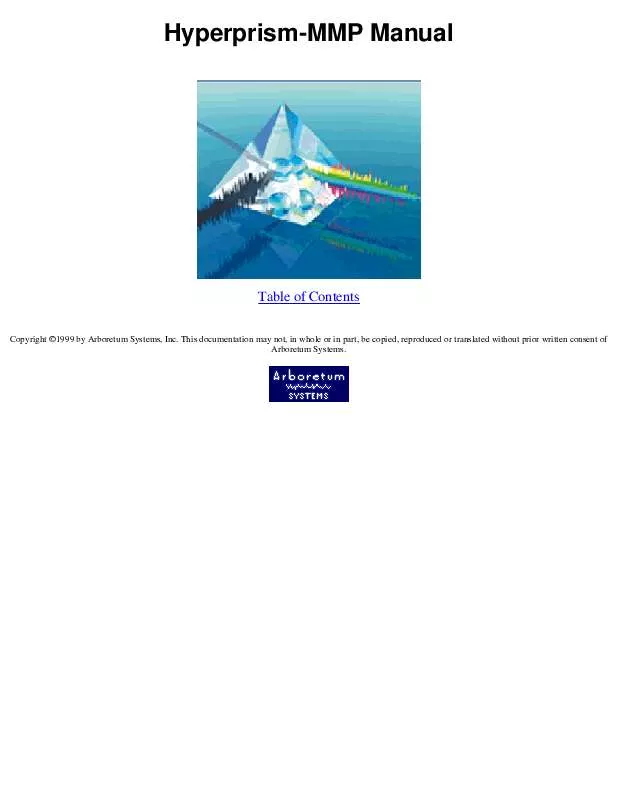User manual ARBORETUM HYPERPRISM-MMP
Lastmanuals offers a socially driven service of sharing, storing and searching manuals related to use of hardware and software : user guide, owner's manual, quick start guide, technical datasheets... DON'T FORGET : ALWAYS READ THE USER GUIDE BEFORE BUYING !!!
If this document matches the user guide, instructions manual or user manual, feature sets, schematics you are looking for, download it now. Lastmanuals provides you a fast and easy access to the user manual ARBORETUM HYPERPRISM-MMP. We hope that this ARBORETUM HYPERPRISM-MMP user guide will be useful to you.
Lastmanuals help download the user guide ARBORETUM HYPERPRISM-MMP.
Manual abstract: user guide ARBORETUM HYPERPRISM-MMP
Detailed instructions for use are in the User's Guide.
[. . . ] Hyperprism-MMP Manual
Table of Contents
Copyright ©1999 by Arboretum Systems, Inc. This documentation may not, in whole or in part, be copied, reproduced or translated without prior written consent of Arboretum Systems.
Hyperprism-MMP for MacOS Premiere Plug-In compatible applications
Digital Audio Signal Processing Software by Arboretum Systems Inc. This documentation current for Hyperprism-MMP version 1. 5. 5, last updated 10/27/98. Copyright ©1997, 1998 by Arboretum Systems, Inc. [. . . ] Choose according to the number of audio channels to be processed. Note that there is no direct mono-to-stereo processing under the AudioSuite format. But you can easily work around this limitation by copying any mono selection to an adjoining track, then selecting both regions for stereo processing. The H-DAS Stereo Room Reverb requires two-channel input or a DAE error message -7450 will result when you attempt to process. Also note that Hyperprism stereo AudioSuite effects require the following settings: Use in Playlist (not Region) and be in Multi-Input Mode.
Hall Reverb
Although there's a lot of excitement about the HyperVerb, we're also still offering our classic reverb algorithms, Hall and Room. The Hall Reverb has an intrinsically longer decay time than the Room Reverb. Both create a diffuse sound field with variable brightness, feedback, wet/dry mix and diffusion, while utilizing a minimum of CPU cycles. Parameters
Mix
Wet/Dry mix, in percentages from 0% (original signal only) to 100% (reverberant signal only) by default.
Feedback
Feedback, from 0% to 100% by default. Higher feedback settings lengthen the time it takes a give sound's reverb to decay to silence. A setting of 0% will result in the shortest possible decay for the algorithm, 100% feedback will linger almost indefinitely. You will typically need to increase your Post Roll value to hear the full decay created by Hyperprism's reverb algorithms when processing a sound to a new file.
Brightness
The brightness slider simulates the loss of high frequencies due to room reflections and atmospheric absorption. In practice, you can consider it a low pass filter applied continuously to the ongoing reverb decay. A setting of 0% will result in very dark sounding reverbs, with very little high-frequency energy. A setting of 100% will be very bright-all the high frequencies from the source sound will persist in the reverberant decay.
Diffusion
Diffusion controls the phase smearing of the reflected sound. Low diffusion settings result in more discrete delayed repeats, while adding diffusion smears out the attacks of each repeat. Higher diffusion results in a smooth wash of sound, without identifiable reflected attacks. Diffusion settings over 100% will induce feedback. Pro Tools/Avid users: Although there's only one H-DAS Hall Reverb plug-in in your DAE folder, the Hall Reverb effect shows up twice in the AudioSuite menu as separate Mono Hall Reverb and Stereo Hall Reverb selections. Choose according to the number of audio channels to be processed. Note that there is no direct mono-to-stereo processing under the AudioSuite format. But you can easily work around this limitation by copying any mono selection to an adjoining track, then selecting both regions for stereo processing. The H-DAS Stereo Hall Reverb requires two-channel input or a DAE error message -7450 will result when you attempt to process. [. . . ] Lower sample rates lose high frequency response, and 8-bit storage causes a reduction of your sound's dynamic range, resulting in noisier, "grainy-sounding" audio, especially during softer passages. If you are creating 8-bit audio (for example, for multimedia or Internet distribution), you will get best results if you do all your signal processing at 16-bits and 44. 1 or 48 kHz, and then create an 8-bit file at the end of the process. The distortion of low-level signals can be minimized by normalizing your 16-bit file before 8-bit conversion, or better still, by using dynamic range compression or manual gain-riding to make soft parts of your sounds louder before reducing their resolution. The use of dither can improve the sound quality of 8-bit audio, although at the expense of a slightly noisier signal. [. . . ]
DISCLAIMER TO DOWNLOAD THE USER GUIDE ARBORETUM HYPERPRISM-MMP Lastmanuals offers a socially driven service of sharing, storing and searching manuals related to use of hardware and software : user guide, owner's manual, quick start guide, technical datasheets...manual ARBORETUM HYPERPRISM-MMP


